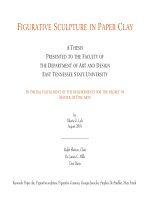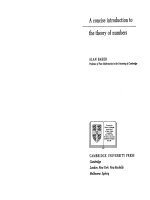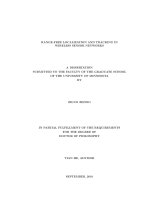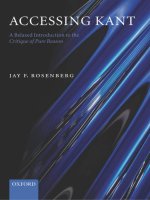A Dissertation Presented to the Faculty of the Graduate School of Cornell University In Partial Fulfillment of the Requirements for the Degree of Doctor of Philosophy potx
Bạn đang xem bản rút gọn của tài liệu. Xem và tải ngay bản đầy đủ của tài liệu tại đây (8.24 MB, 140 trang )
MECHANICAL AND ELECTRICAL PROPERTIES OF GRAPHENE SHEETS
A Dissertation
Presented to the Faculty of the Graduate School
of Cornell University
In Partial Fulfillment of the Requirements for the Degree of
Doctor of Philosophy
by
Joseph Scott Bunch
May 2008
© 2008 Joseph Scott Bunch
MECHANICAL AND ELECTRICAL PROPERTIES OF GRAPHENE SHEETS
Joseph Scott Bunch, Ph. D.
Cornell University 2008
This thesis examines the electrical and mechanical properties of graphene
sheets. We perform low temperature electrical transport measurements on gated,
quasi-2D graphite quantum dots. In devices with low contact resistances, we use
longitudinal and Hall resistances to extract a carrier density of 2-6 x 10
11
holes per
sheet and a mobility of 200-1900 cm
2
/V-s. In devices with high resistance contacts, we
observe Coulomb blockade phenomena and infer the charging energies and capacitive
couplings. These experiments demonstrate that electrons in mesoscopic graphite
pieces are delocalized over nearly the whole graphite piece down to low temperatures.
We also fabricate nanoelectromechanical systems (NEMS) from ultra thin
graphite and graphene by mechanically exfoliating thin sheets over trenches in SiO
2
.
Vibrations with fundamental resonant frequencies in the MHz range are actuated
either optically or electrically and detected optically by interferometry. We
demonstrate room temperature charge sensitivities down to 2x10
-3
e/Hz
½
. The thinnest
resonator consists of a single suspended layer of atoms and represents the ultimate
limit of a two dimensional NEMS.
In addition to work on doubly clamped beams and cantilevers, we also
investigate the properties of resonating drumheads, which consist of graphene sealed
microchambers containing a small volume of trapped gas. These experiments allow us
to probe the membrane properties of single atomic layers of graphene. We show that
these membranes are impermeable and can support pressure differences larger than
one atmosphere. We use such pressure differences to tune the mechanical resonance
frequency by ~100 MHz. This allows us to measure the mass and elastic constants of
graphene membranes. We demonstrate that atomic layers of graphene have stiffness
similar to bulk graphite (E ~ 1 TPa). These results show that single atomic sheets can
be integrated with microfabricated structures to create a new class of atomic scale
membrane-based devices.
iii
BIOGRAPHICAL SKETCH
Joseph Scott Bunch was born on November 8, 1978 in Miami, Florida. He
attended elementary, middle, and high school in Miami. After high school, he
remained in Miami and enrolled at Florida International University (FIU) where he
received his B.S. degree in physics in 2000. While at FIU, he was introduced to
nanoscience research through an undergraduate research opportunity studying
electrodeposition of metallic nanowires in Professor Nongjian Tao’s lab. He also spent
one summer in a research program at the University of Tennessee, Knoxville working
with a scanning tunneling microscope in Professor Ward Plummer’s lab. After
graduation from FIU, Scott was awarded a graduate fellowship from Lucent
Technologies, Bell Laboratories to continue his education. He spent the summer of
2000 at Bell Laboratories in Murray Hill, N.J. working with Nikolai Zhitenev on the
electrodeposition of scanning single electron transistor tips. In August 2000, he
enrolled in the physics department at Cornell University where he joined Paul
McEuen’s group and continued nanoscience research. His research focused primarily
on the electrical and mechanical properties of graphene. After finishing his Ph.D. in
May 2008, Scott will do postdoctoral research on mass sensing with
nanoelectromechanical systems in Professor Harold Craighead and Professor Jeevak
Parpia’s lab at Cornell University before heading off to Colorado in August 2008 to
become an Assistant Professor of Mechanical Engineering at the University of
Colorado at Boulder.
iv
To my family
v
ACKNOWLEDGMENTS
When I first arrived at Cornell University and joined Paul McEuen’s lab, it was
a lonely and empty place. Paul and his lab were still at Berkeley so the labs at Cornell
were just empty rooms. I sat at my desk staring at freshly painted white walls and
began to ponder whether I would survive the long years of a Ph.D. in such a dreary
setting. Fortunately, things soon changed with the arrival of equipment and people that
was to transform the corridors of Clark Hall to a lively and exciting place to work. It
was truly been a pleasure working alongside a great group of scientists and people.
The most important influence on the successful completion of this thesis was
my advisor, Paul McEuen. He has had greatest professional influence on my
development as a scientist. He is an amazing scientist and mentor. He pushed me to
develop my weaknesses and exploit my strengths. His courage to tackle new and
difficult problems and his patience to withstand the many failures that accompany
such risks is admirable. As a soon to be advisor to students, I only hope that some of
his wisdom has rubbed off on me so that I may share it with my new graduate
students.
One of the many remarkable things about Paul is his ability to attract and fill
his lab with a wonderful group of people. I had the opportunity to work and learn from
great postdocs. I worked with Alex Yanson during my first years and shared with him
the displeasure of unsuccessfully trying to reproduce many of Hendrik Schon’s
phenomenal papers on molecular crystals with him. We later learned that these results
were part of one of the largest cases of scientific fraud in recent scientific memory.
Jiyong Park taught me how to use scanning probe microscopes. Though we never got
around to finishing a paper based on this work, I still learned a great deal. Yuval Yaish
worked closely with me for the work discussed in Chapter 4 of this thesis and taught
vi
me how to make low temperature electrical measurements. The postdocs I didn’t get
to work with directly but from which I learned a lot are Jun Zhu, Ken Bosnick,
Patrycja Paruch, Zhaohui Zhong, Yaquiong Xu, and Shahal Ilani. Besides being
mentors these postdocs were also all good friends. Discussions with Shahal and
Zhaouhui were especially helpful in shaping research ideas and proposals.
One of the wonderful aspects of doing a Ph. D. is going through it together
with other graduate students. I was lucky enough to work with a phenomenal batch in
Paul’s lab. The original batch included those that followed Paul from Berkeley:
Jiwoong Park, Ethan Minot, and Michael Woodside. This was quickly followed by the
first Cornell batch: Markus Brink, Sami Rosenblatt, and Vera Sazonova. Later they
were joined by Luke Donev, Lisa Larrimore, Xinjian “Joe” Zhou, Arend van der
Zande, Nathan Gabor, Samantha Roberts, and Jonathan Alden . Life outside of the lab
was memorable with this group: disagreeing about politics with Markus and Sami,
acting in skits with Markus, Vera, Luke, Ethan, and Sami, and attempts to make a
Hollywood blockbuster with Joe. I will miss you all.
For the work in this thesis, I must give special thanks to collaborators. Markus
Brink helped me with the experiments in Chapter 4. He taught me everything I know
about ebeam lithography. Kirill Bolotin helped me with the low temperature
experiments in Chapter 4 and taught me everything I know about dilution fridges.
Arend van der Zande was instrumental in our success with the suspended graphene
resonators presented in Chapter 5 and 6. He was with me on both projects from the
very early beginnings, helped fabricate many of the devices we used, his analytical
abilities helped us solve problems we encountered, and I find myself always wanting
to discuss nanomechanics with him whenever a new problem comes to mind. I am also
indebted to him for taking over the editing of the first paper while I was in Korea
meeting my future in laws and for his impressive cartoon image of suspended
vii
graphene that helped popularize our work. I must also thank Ian Frank and Professor
David Tanenbaum for help during the summer of 2006 when most of the work of
Chapter 5 was completed. Ian Frank fabricated our first single layer suspended
graphene membrane. The work in Chapter 6 couldn’t have been done without the help
of Jonathan Alden. After spending only a very short time in Paul’s lab he joined onto
the graphene membrane project and made several critical contributions. Most
importantly, he fabricated the first single atomic layer sealed membrane. He was also
responsible for much of the theory behind that paper. His attention to detail and
MatLab ability far exceed mine, and it was privilege to have the opportunity to work
with him.
I want to thank Arend and Jonathan for reading my whole thesis and giving me
a lot of valuable criticisms and suggestions. I couldn’t incorporate all of their
suggestions, so do not fault them if you find parts of this thesis disagreeable or in need
of revision.
A crucial part of the success of many of the experiments in this thesis was the
result of a fruitful collaboration with Harold Craighead and Jeevak Parpia’s lab. This
began when I headed over to the other side of Clark Hall, and Arend introduced me to
Scott Verbridge. I asked him if we can load are recently fabricated suspended
graphene devices into his NEMS Actuation/Detection setup and see if they resonated.
He agreed and within a few minutes we had our first vibrating graphene resonators. I
am thankful to the continued support of Professor Harold Craighead and Professor
Jeevak Parpia. They were always supportive of all my NEMS endeavors, and I am
excited to be joining their lab soon to spend 3 months as a postdoc and continue my
NEMS education from these two masters. The data presented in Chapter 5 and 6 of
this thesis resulted from our collaboration.
Professor Jiwoong Park and his graduate student Lihong Herman helped us
viii
calibrate the spring constant of AFM tips for experiments presented in Chapter 6. I
would like to thank my committee members, Veit Elser and Rob Thorne, for sitting
through 3 exams with me and reading this thesis. I would also like to thank the great
support staff at Cornell and the secretaries that take care of the paperwork and
negotiate the grand bureaucracies of the academic world, Douglas Milton, Judy
Wilson, Deb Hatfield, Kacey Bray, Larissa Vygran, and Debbie Sladdich. I’d also like
to thank Stan Carpenter and the guys in the professional machine shop. I also want to
thank Christopher “Kit” Umbach for all his help with Raman spectroscopy and Victor
Yu-Juei Tzen for the cartoon image of the graphene membrane in Chapter 6.
I would like to thank my friends, especially the members of the F.B.I. – you
know who you all are and so as not to incriminate too many people, I will leave you
all nameless. I would like to thank my good friend and roommate for 5 years Sahak
Petrosyan. Together we shared many wonderful memories and his friendship is
something I will cherish a lifetime. I also want to thank Saswat Sarangi and Faisal
Ahmad who were great friends and neighbors. I can write a whole other 100 page
thesis which chronicles the adventures we had in Ithaca, from overnight attempts to
reach Miami to far crazier adventures that are better left untold, at least until names
can be changed to protect the innocent. The friendships I made while at Cornell I will
cherish a lifetime.
I want to thank my family who I owe so much and to whom I dedicate this
thesis. My brother and sister shaped my life while growing up and as we go through
life they continue to be in my thoughts. I want to thank my parents. It is their love and
support through the years that brought me to Cornell and their love for their family
and each other continues to inspire me to this day.
The greatest thing about my time in Ithaca was meeting my wife, Heeyoun. I
am blessed to have met her and consider her to be my greatest discovery while at
ix
Cornell. She is a great source of inspiration to me, and I love her deeply. Finally, I
would like to thank the newest addition to my family, my daughter, Daniella. I tried to
complete this thesis before she was born, but she seemed more motivated than I was
and beat me to it by coming 12 days before her due date.
The words and ideas that follow represent only a small share of everything that
happened while completing this thesis. There were many failures mixed in with the
occasional success. It is the success that you read in these pages, but it is the
undocumented failures and minor successes that also make up this thesis. It is because
of the group of people described above, that all of this was possible. During my time
at Cornell, I made scientific and personal discoveries, published papers, performed in
plays, made movies, traveled, developed lifelong friendships, got married, and became
a father. There is a running joke with my friends that life can only go downhill from
here. As I sit down to finish writing these acknowledgements in the hospital room
where my one day old daughter, Daniella, and wife, Heeyoun, are lying next to each
other sleeping, I am reminded that the completion of this thesis represents the closing
of one memorable phase of my life, but a new and more rewarding phase awaits.
x
TABLE OF CONTENTS
Page
Biographical Sketch iii
Dedication iv
Acknowledgements v
List of Figures xiv
List of Tables xvi
Chapter 1. INTRODUCTION
1.1 Introduction 1
1.2 Outline 1
1.3 Electrical Properties of Materials 2
1.4 Two Dimensional Electron Systems 6
1.5 Quantum Dots 10
1.6 Conclusions 14
Chapter 2. NANOMECHANICS
2.1 Mechanical Properties of Materials 15
2.2 Anisotropic Materials 18
2.3 Biaxial Strain 19
2.4 Bulge Test 19
2.5 Nanoindentation 23
2.6 Harmonic Oscillator 24
2.7 Doubly Clamped Beams and Cantilevers 26
2.8 Membrane Dynamics 27
2.9 Plate Dynamics 28
2.10 Actuation 29
2.11 Optical Detection 30
xi
2.12 MEMS and NEMS Applications 33
2.13 Conclusions 33
Chapter 3. GRAPHENE
3.1 Carbon vs. Silicon 36
3.2 Forms of Carbon 38
3.3 Graphene Fabrication 42
3.4 Electrical Properties of Graphene 45
3.5 Mechanical Properties of Graphite and Graphene 47
3.6 Cornell NEMS Band 50
Chapter 4. COULOMB OSCILLATIONS AND HALL EFFECT IN QUASI-2D
GRAPHITE QUANTUM DOTS
4.1 Introduction 52
4.2 Device Fabrication 53
4.3 Device Characterization 53
4.4 Data Analysis 55
4.5 Coulomb Blockade 57
4.6 Magnetic Field Dependence 61
4.7 Conclusions 61
Chapter 5. ELECTROMECHANICAL RESONATORS FROM GRAPHENE
SHEETS
5.1 Introduction 64
5.2 Device Fabrication 65
5.3 Device Characterization – AFM and Raman 65
5.4 Resonance Measurements 67
5.5 Resonance Spectrum 69
5.6 Tension 73
xii
5.7 Young’s Modulus 73
5.8 Tuning the Resonance Frequency 74
5.9 Quality factor 77
5.10 Vibration Amplitude 79
5.11 Thermal Noise Spectrum 79
5.12 Sensitivity 81
5.13 Conclusions 83
Chapter 6. IMPERMEABLE ATOMIC MEMBRANES FROM GRAPHENE
SHEETS
6.1 Introduction 84
6.2 Device Fabrication 86
6.3 Pressure Differences 86
6.4 Leak Rate 88
6.5 Elastic Constants 91
6.6 Surface Tension 92
6.7 Self-Tensioning 96
6.8 Conclusions 97
Chapter 7. CONCLUSIONS
7.1 Summary 98
7.2 Future outlook 99
APPENDIX
A.1 Slack and Self-Tensioning in Graphene Membranes at p = 0 102
A.2 Measuring the Gas Leak Rates 104
A.3 Tunneling of He Atoms across a Graphene Sheet 106
A.4 Classical Effusion through Single Atom Lattice Vacancies 106
A.5 Extrapolating Deflections and Pressure Difference 107
xiii
A.6 Experimental Setup for Optical Drive and Detection 108
REFERENCES 113
xiv
LIST OF FIGURES
Page
Fig. 1.1 Hall Bar Geometry 5
Fig. 1.2 Two Dimensional Electron Systems 7
Fig. 1.3 Temperature Dependence of 2DEG Mobility 9
Fig. 1.4 Quantum Dots 11
Fig. 2.1 Poisson’s Ratio 17
Fig. 2.2 Bulge Test 21
Fig. 2.3 Damped Harmonic Oscillator 25
Fig. 2.4 Optical Detection of Resonant Motion 32
Fig. 2.5 MEMS Market Revenues and Forecast 34
Fig. 3.1 Silicon Microelectronics and Microelectromechanical Systems 37
Fig. 3.2 Forms of Carbon 39
Fig. 3.3 Graphene Fabrication 43
Fig. 3.4 Electronic Properties of Graphene 46
Fig. 3.5 Cornell NEMS Band 51
Fig. 4.1 Few Layer Graphene Quantum Dot Fabrication 54
Fig. 4.2 Scatter Plot of Resistance and Device Schematic 56
Fig. 4.3 Longitudinal and Hall Resistance 58
Fig. 4.4 Coulomb Blockade Measurements 60
Fig. 4.5 Magnetic Field Dependence of Coulomb Blockade Peaks 62
Fig. 5.1 Graphene Resonator Schematic, Images, and Raman Spectroscopy 66
Fig. 5.2 Experimental Setup Schematic for NEMS Actuation and Detection 68
xv
Fig. 5.3 Mechanical Resonance and Resonance Spectrum 70
Fig. 5.4 Fundamental Mode vs. t/L
2
72
Fig. 5.5 Electrical Drive 75
Fig. 5.6 Negative Frequency Tuning 76
Fig. 5.7 Quality Factor vs. Thickness 78
Fig. 5.8 Thermal Noise and Drive Calibration 80
Fig. 6.1 Graphene Sealed Microchamber Fabrication 85
Fig. 6.2 Air Leak and Bulge Test on Single Layer 87
Fig. 6.3 Leak Rates vs. Thickness 89
Fig. 6.4 Tuning the Resonance Frequency with Pressure 93
Fig. 6.5 Initial Tension in the Graphene Membrane 95
Fig. A.1 AFM Amplitude and Deflection vs. Distance to Graphene 103
Fig. A.2 Real Time Resonance Frequency Detection of Helium Leak 105
Fig. A.3 Detailed Schematic of Optical NEMS Setup 112
xvi
LIST OF TABLES
Page
Table 1.1 Young’s Modulus of Various Materials 16
1
CHAPTER 1
INTRODUCTION
1.1 Introduction
The discovery of a new material brings with it some of the most exciting and
fruitful periods of scientific and technological research. With a new material come
new opportunities to reexamine old problems as well as pose new ones. The recent
discovery of graphene- atomically thin layers of graphite- brought such a period
(Novoselov, Geim et al. 2004). For the first time, it is possible to isolate single two-
dimensional atomic layers of atoms. These are among the thinnest objects imaginable.
The strongest bond in nature, the C-C bond covalently locks these atoms in place
giving them remarkable mechanical properties (Bunch, van der Zande et al. 2007;
Meyer, Geim et al. 2007; Bunch, Verbridge et al. 2008). A suspended single layer of
graphene is one of the stiffest known materials characterized by a remarkably high
Young’s modulus of ~ 1 TPa. As an electronic material, graphene represents a new
playground for electrons in 2, 1, and 0 dimensions where the rules are changed due to
its linear band structure. Scattering is low in this material allowing for the observation
of the Quantum Hall Effect (QHE), and the unique band structure of graphene gives
this old effect a new twist (Novoselov, Geim et al. 2005; Zhang, Tan et al. 2005).
Graphene research is still in its infancy and this thesis examines only the very
beginnings of what will likely be an important material of the future.
1.2 Outline
This thesis presents some of the first experiments on the electrical and
mechanical properties of graphene. Chapters 1-3 include an overview of the basic
concepts relevant to the experimental results presented in Chapters 4-6. The
2
experimental section begins in Chapter 4 where we perform low temperature electrical
transport measurements on gated, few-layer graphene quantum dots. We find that
electrons in mesoscopic graphite pieces are delocalized over nearly the whole graphite
piece down to low temperatures. A modified form of this chapter is published in Nano
Letters 5, 287 (2005). An experimental study of the mechanical properties of
suspended graphene begins in Chapter 5 where we study doubly clamped beams and
cantilevers fabricated from graphene sheets. We fabricate the world’s thinnest
mechanical resonator from a suspended single layer of atoms. A version of this
chapter is published in Science 315, 490 (2007). Chapter 6 extends this work on
mechanical resonators from graphene sheets to graphene membranes which are
clamped on all sides and seal a small volume of gas in a microchamber. In this work
we demonstrate that a graphene membrane is impermeable to gases down to the
ultimate limit in thickness of only one atomic layer. A version of this chapter will
appear in Nano Letters (2008).
1.3 Electrical Properties of Materials
Physicists love forces. Forces are one of the basic means by which they
characterize materials. When presented with a new material they immediately want to
know two things: how the electrons in the material respond to electrical forces and
how the atoms respond to mechanical forces. The first of these is summed up by
Ohm’s Law:
IRV =
(1.1)
where V is the voltage difference across the conductor, I is the current, and R is the
resistance. A useful way to express this resistance is in terms of a resistivity defined
as:
3
A
L
R
ρ
=
(1.2)
where L is the length of the material and A is the cross sectional area through which
the current is flowing. The resistivity is of a material is independent of its geometry
making it a useful quantity to compare different materials.
Ohm’s law is a general formula applicable to 3D, 2D, and 1D conductors. In a
typical conductor charges are moving and scattering at random with no net movement
of charge across the sample. This situation changes when a voltage difference, V, is
applied across the conductor. The voltage difference creates an electric field, E, which
gives these randomly scattered electrons a net force in one direction. Some of the
possible scattering mechanisms are phonons in the material, defects in the lattice, or
charge inhomogeneities in the material. The velocity with which the charges move in
the direction of the applied field is known as the drift velocity, v
d
and is related to the
current density J by:
J = nev
d
(1.3)
where n is the charge carrier density and e is the electron charge. When there is less
scattering in a material, the charge carriers will travel farther with the same electric
field. This ratio is defined as the mobility, µ = v
d
/E and is an important quantity that is
used to characterize scattering in conductors. One can then express the resistivity of a
material in terms of its mobility by:
= 1/(ne µ). (1.4)
4
Hall Effect:
Physicists aren’t limited to applying electrical forces to a material but love to
apply magnetic forces as well. In a magnetic field, a moving charge experiences a
Lorentz force. Using the Drude model with an applied magnetic field B, the current
density is defined as:
⎟
⎠
⎞
⎜
⎝
⎛
×−= Bj
ne
EJ
r
r
r
v
11
0
ρ
(1.5)
which can be rewritten as:
Bj
ne
jE
r
r
r
r
×+=
1
0
ρ
(1.6)
We can then formulate this equation in matrix form using Cartesian coordinates and
under the assumption that we have a 2D system with a B field in the z direction and
current in the xy plane. Doing so we get:
⎟
⎟
⎠
⎞
⎜
⎜
⎝
⎛
⎟
⎟
⎟
⎟
⎠
⎞
⎜
⎜
⎜
⎜
⎝
⎛
−
=
⎟
⎟
⎠
⎞
⎜
⎜
⎝
⎛
y
x
y
x
j
j
ne
B
ne
B
E
E
0
0
ρ
ρ
(1.7)
Referring to Fig. 1.1, we define the Hall resistance, R
H
, as:
I
V
R
h
H
≡ (1.8)
where:
∫
⋅= ldEV
yh
(1.9)
5
Figure 1.1 Hall Bar geometry.
6
With no current flow in the y direction (1.7) simplifies to:
xy
j
ne
B
E −= (1.10)
Plugging (1.10) into (1.9) we get:
Wj
ne
B
dj
ne
B
V
xxh
==
∫
l
(1.11)
In 2 dimensions the current density is defined as:
W
I
j
x
≡ (1.12)
Using this fact along with the definition for the Hall voltage in (1.8) we have that:
ne
B
R
H
= (1.13)
By sweeping a perpendicular magnetic field,
B, and measuring R
H
one can determine
the carrier density,
n. You can then use this density and the measured longitudinal
resistivity
to measure the sample’s mobility µ. This is a technique known as the Hall
Effect and is commonly used to characterize conducting samples. We will use this in
Chapter 4 to determine
n, , and µ for mesoscopic graphene pieces.
1.4 Two Dimensional Electron Systems
Up until this point, we concerned ourselves with 3 dimensional conductors. If
the thickness of a conductor becomes smaller than the size of the electron wavelength
than the conductor forms a two-dimensional electron gas (2DEG) and interesting
7
Figure 1.2. a) A silicon MOSFET where a metal gate is used to
pull charges towards the Silicon/Silicon Oxide interface where the
2DEG is formed. b) A modulation doped GaAs/AlGaAs
heterojunction. The 2DEG forms at the interface where charges
introduced by silicon dopants are pulled to the interface by an
electric field.









